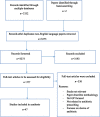Context and general practitioner decision-making - a scoping review of contextual influence on antibiotic prescribing
- PMID: 34781877
- PMCID: PMC8591810
- DOI: 10.1186/s12875-021-01574-x
Context and general practitioner decision-making - a scoping review of contextual influence on antibiotic prescribing
Abstract
Background: How contextual factors may influence GP decisions in real life practice is poorly understood. The authors have undertaken a scoping review of antibiotic prescribing in primary care, with a focus on the interaction between context and GP decision-making, and what it means for the decisions made.
Method: The authors searched Medline, Embase and Cinahl databases for English language articles published between 1946 and 2019, focusing on general practitioner prescribing of antibiotics. Articles discussing decision-making, reasoning, judgement, or uncertainty in relation to antibiotic prescribing were assessed. As no universal definition of context has been agreed, any papers discussing terms synonymous with context were reviewed. Terms encountered included contextual factors, non-medical factors, and non-clinical factors.
Results: Three hundred seventy-seven full text articles were assessed for eligibility, resulting in the inclusion of 47. This article documented the experiences of general practitioners from over 18 countries, collected in 47 papers, over the course of 3 decades. Contextual factors fell under 7 themes that emerged in the process of analysis. These were space and place, time, stress and emotion, patient characteristics, therapeutic relationship, negotiating decisions and practice style, managing uncertainty, and clinical experience. Contextual presence was in every part of the consultation process, was vital to management, and often resulted in prescribing.
Conclusion: Context is essential in real life decision-making, and yet it does not feature in current representations of clinical decision-making. With an incomplete picture of how doctors make decisions in real life practice, we risk missing important opportunities to improve decision-making, such as antibiotic prescribing.
Keywords: Antibiotics; Context; Contextual factors; Contextual influence; Decision-making; General practice; Non-medical factors; Prescribing.
© 2021. The Author(s).
Conflict of interest statement
The authors declare that they have no competing interests
Figures
References
-
- Norman G. Research in clinical reasoning: past history and current trends. Med Educ. 2005;39(4):418–427. - PubMed
-
- Schmidt HG, Norman GR, Boshuizen HP. A cognitive perspective on medical expertise: theory and implication [published correction appears in Acad Med 1992 Apr;67(4):287] Acad Med. 1990;65(10):611–621. - PubMed
-
- Elstein AS, Schulman LS, Sprafka SA. Medical problem solving: an analysis of clinical reasoning. Cambridge: Harvard University Press; 1978.
-
- Coderre S, Mandin H, Harasym PH, Fick GH. Diagnostic reasoning strategies and diagnostic success. Med Educ. 2003;37(8):695–703. - PubMed
-
- Cook DA, Sherbino J, Durning SJ. Management reasoning: beyond the diagnosis. JAMA. 2018;319(22):2267–2268. - PubMed
Publication types
MeSH terms
Substances
LinkOut - more resources
Full Text Sources
Research Materials


